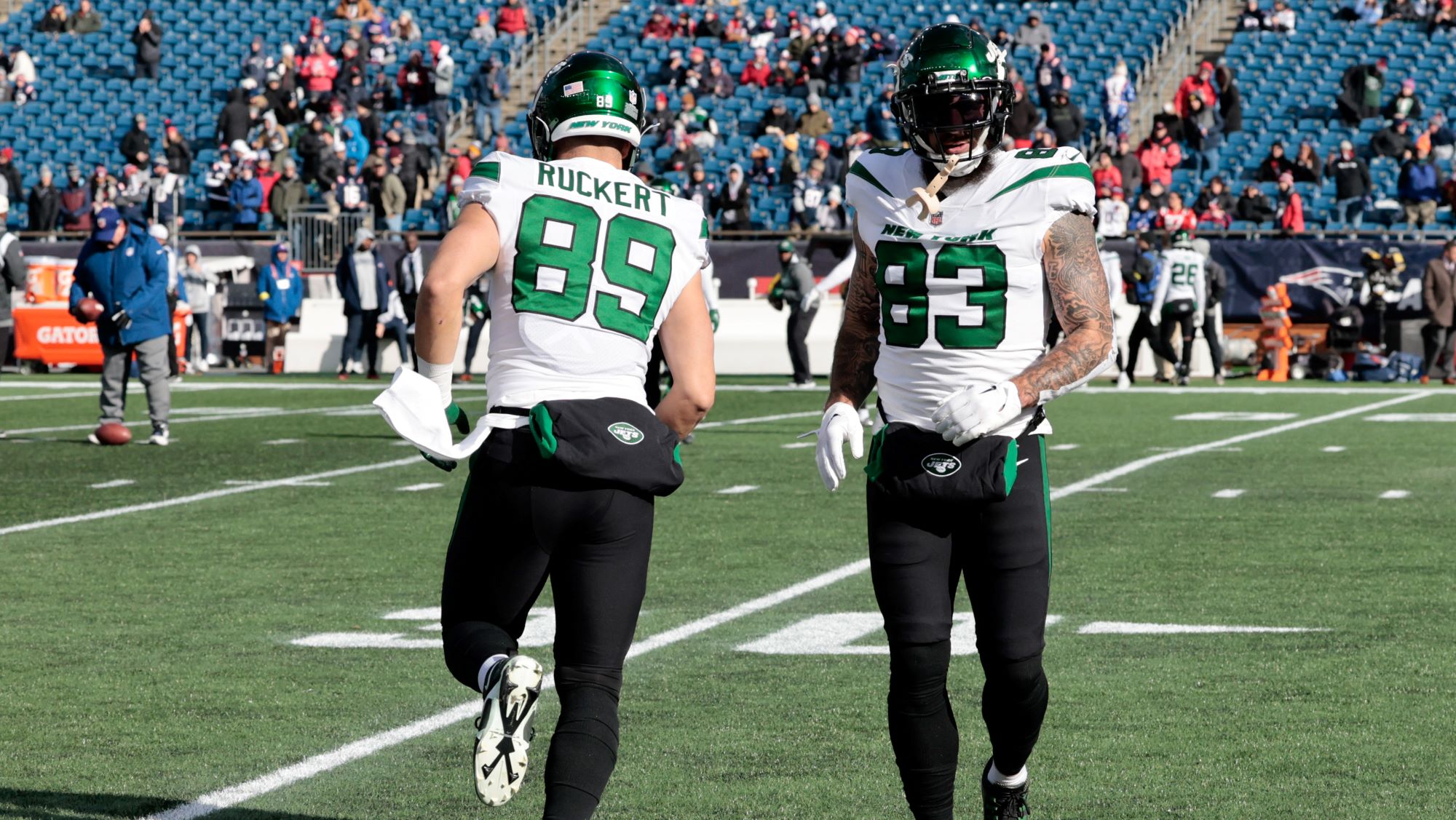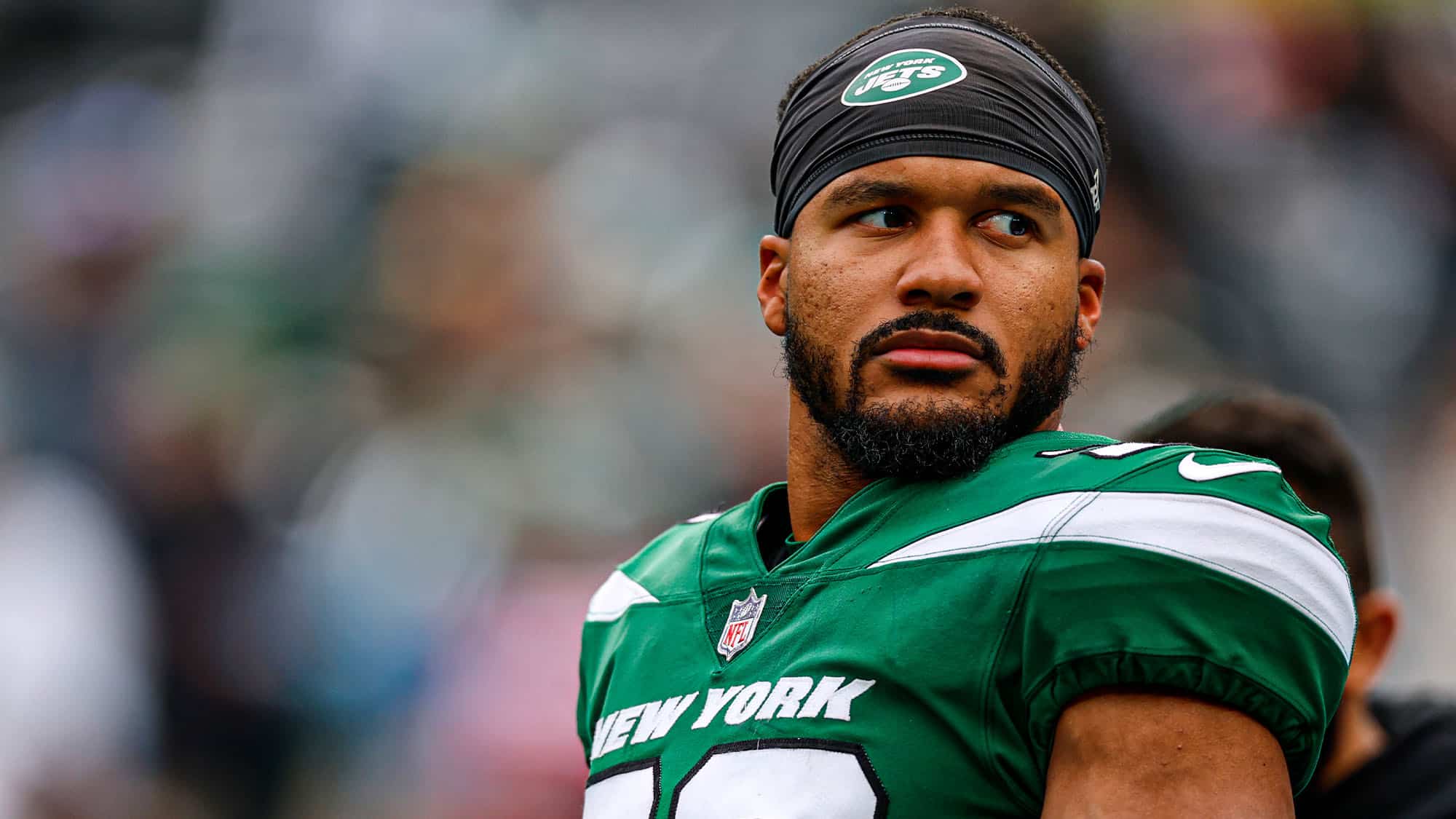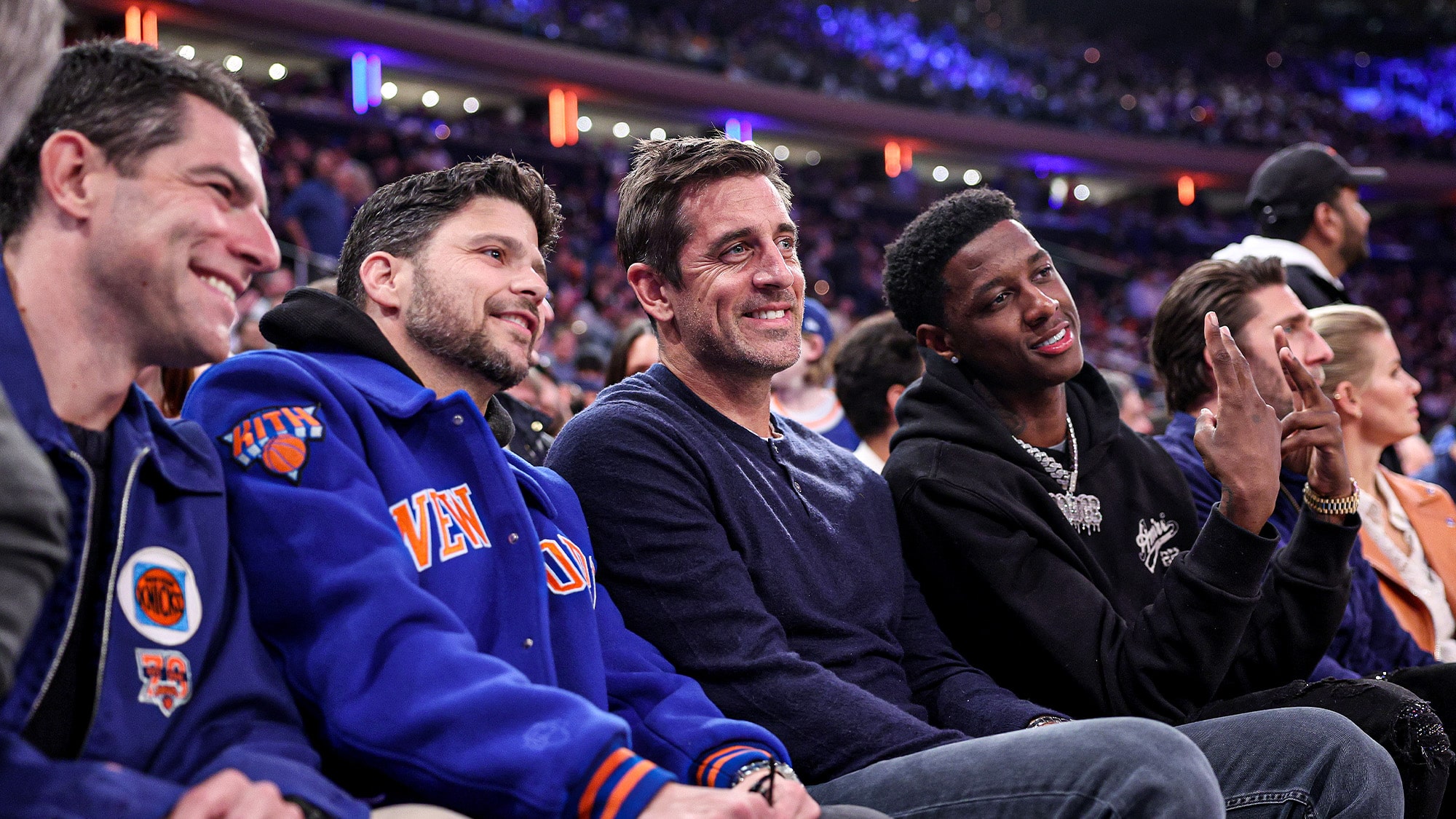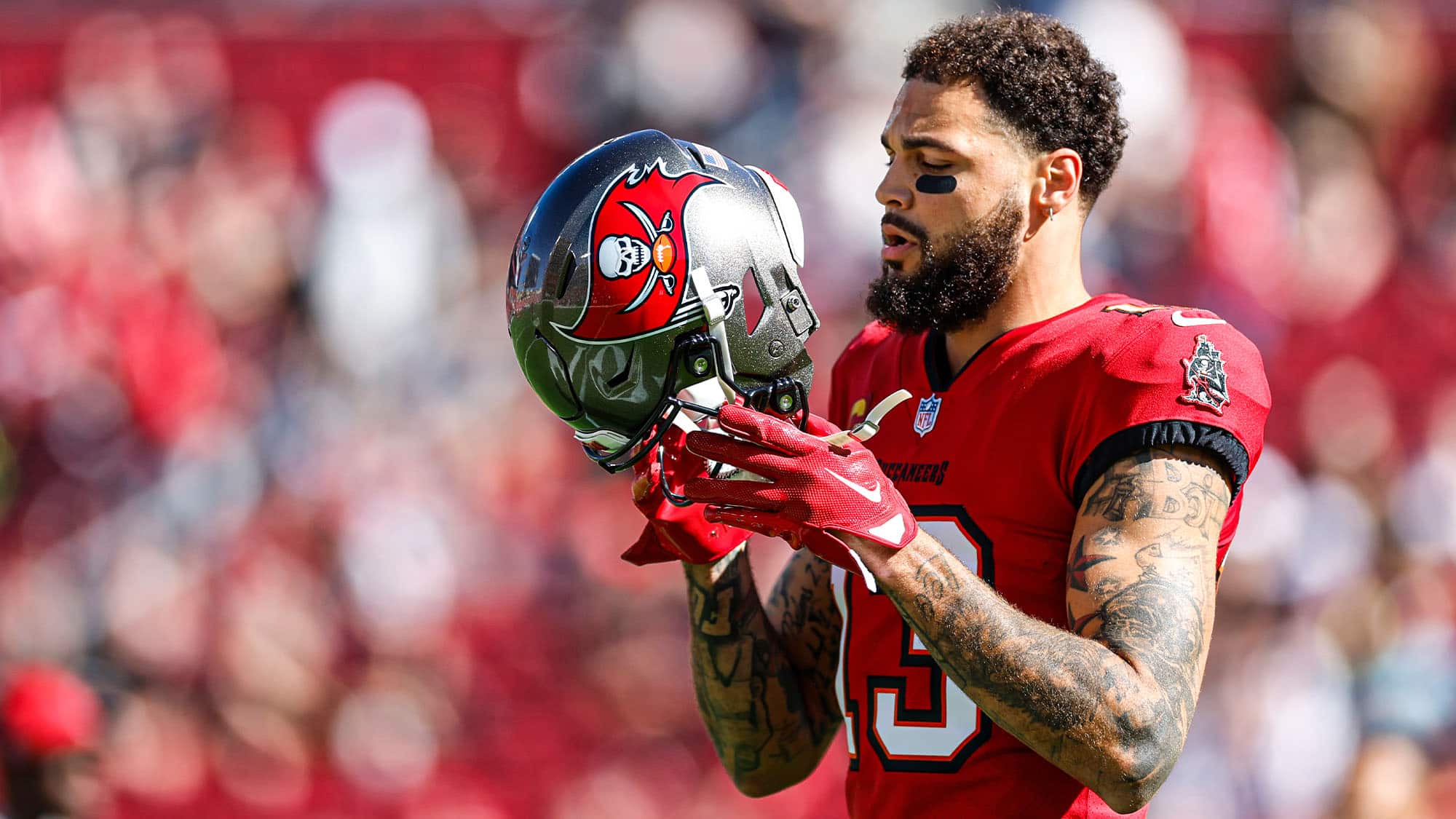The Jets have too much talent to waste at the TE position
In the 2022 offseason, the New York Jets made a trio of tight end moves designed to turn a team weakness into a strength. Some would even say that they went a bit too far, locking up both Tyler Conklin and C.J. Uzomah to starter-caliber contracts while simultaneously spending a third-round pick on Jeremy Ruckert, whom many considered the best tight end in the draft.
Heading into the season, most Jets fans were excited to see how the Jets would roll out the trio. There was a widespread assumption that Ruckert might redshirt at the beginning of the year due to his placement on the PUP list for part of training camp. Still, Conklin and Uzomah were seen as a strong one-two punch, complementing each other’s skills in both the pass and run games.
Exiting the season, though, the Jets’ tight end performance cannot be described as anything but lackluster. Ruckert did not just redshirt at the beginning of the season, but almost the entire year. Uzomah saw just 26 targets all year. Conklin tied for 11th among 42 qualified tight ends (min. 35 targets) with 58 receptions, but his 1.13 yards per route run ranked 30th, and his 6.5% drop rate was 27th. Conklin did catch 9-of-13 contested targets for a second-best 69.2% rate, but he also had three interceptions thrown his way, two of which were off his hands, resulting in a 35th-ranked 80.0 targeted QB rating.
Uzomah was used almost exclusively as a run-blocker, and, contrary to many Jets fans’ perceptions, he did so mostly poorly. As Michael Nania detailed, Uzomah was the Jets’ fourth-worst run-blocker among those with at least 15 attempts, recording just a 1.16 assist-to-stuff ratio (average is about 2.0-to-1).
Considering these numbers, it would appear that there was a lot of meat left on the bone at the tight end position for the Jets.
Furthermore, the NFL playoffs are showing the importance of a tight end in today’s passing game. With defenses playing more two-high safety structures than ever before, finding the soft spots in the middle of the field is ever more crucial. A tight end who can beat linebackers over the middle is a lethal weapon, indeed, as Travis Kelce, George Kittle, Dallas Goedert, and Hayden Hurst have demonstrated. In the first round of the playoffs, Evan Engram, Daniel Bellinger, and T.J. Hockenson further showed the value of the TE position.
Do the Jets have the talent at the position to get similar value? How can they best deploy their tight ends in 2023?
Formations
The Jets ran plays from 12 personnel 22.5% of the time, which was the ninth-highest rate in football. However, their 4.6 yards per play average in that formation was tied for the third-worst in the NFL. Although their 5.2 yards per play average out of 11 personnel wasn’t much better, ranking fifth-worst in the league, their output from 11 was still considerably superior to their output from 12.
Furthermore, the Jets’ usage of 12 personnel in the run game was an unmitigated disaster. Their rush success rate out of 12 was just 31.5%, the third-worst in the NFL. Although their rush success rate wasn’t much better rank-wise out of 11 personnel—they were the eighth-worst—the team’s quantitative rush success rate was still considerably higher with just one TE, at 41.2%.
Where this affected the tight ends was specifically in their target share. Tyler Conklin received 83% of his targets out of 11 personnel, largely because the Jets ran out of 11 personnel 70.6% of the time. Just 10.8% of his targets came out of 12 personnel. C.J. Uzomah’s smaller target share still led him to receive 58% of his targets out of 11 compared to 30.7% out of 12.
To be fair, the Jets ran much fewer plays out of 12 personnel (241 vs. 732), and their run-pass splits were just about 50% out of 12. But the fact that the Jets ran 111 pass plays out of 12 personnel and only gave their tight ends 17 of those targets speaks to an underutilization.
If the Jets want to get their tight ends on the field together, they need to start using them more creatively. Either way, they must utilize better run/pass splits with one tight end on the field to mitigate predictability.
Get Started: Learn More About Becoming A Jet X Member
Route tree
Tyler Conklin was brought in because of his ability to win one-on-one matchups against linebackers, which is his biggest strength. Instead, the Jets sent him to the flat 19.7% of the time, the sixth-highest rate among 41 qualified TEs (min. 200 routes). They underused him on hitches at 19.5% of his route tree, which was 20th but did not maximize his talents; for reference, the Chiefs ran Travis Kelce on hitches 30.3% of the time.
Meanwhile, C.J. Uzomah’s route tree was similarly mishandled. He went to the flat 18.8% of the time. Strangely, he was sent on go routes 14.9% of the time, the 17th-highest rate. Even if that was used as a clear route, why clear with the guy who is so obviously running a clear route?
Uzomah’s biggest strength as a receiving tight end is YAC, unlike Conklin’s. While the Jets sent both TEs on a fair rate of slant routes, it was Conklin who ranked second in slant rate at 8.5%, while Uzomah was 14th at 5.3%. Why not reverse those numbers to get Uzomah a chance to run with the ball?
Red zone
Incredibly, the Jets targeted their tight ends just five times the entire season in the red zone. Four of them resulted in touchdowns.
The tight end is an offense’s biggest weapon in the red zone. Instead, the Jets completely went to sleep in that area. It’s no wonder that the Jets were 31st in red-zone TD rate at just 43.5%. It’s incredible that with a significant upgrade in offensive weapons from 2021, the Jets’ red-zone conversion rate fell by over 10%.
Whoever the new offensive coordinator is will need to remedy that. Whatever the underutilization of the tight ends may be, they’re key in the red zone. Consider the four TDs that the Jets did score to tight ends in the red zone; this is exactly how teams use their TEs for red-zone conversions. Furthermore, Conklin’s touchdowns against the Patriots showcase how his route-running skills were woefully underused by Mike LaFleur.
Pass blocking
Mike LaFleur asked his tight ends to do way too much in pass-blocking. He often had them coming all the way across the formation to take on edge rushers one-on-one. Predictably, they struggled immensely.
Among 34 qualified tight ends (min. 35 pass-blocking snaps), Conklin ranked 32nd with an 11.29% pressure rate and 24th with a 3.23% sack + hit rate. While Uzomah was 18th with a 7.89% pressure rate, every single one of those pressures was either a sack or hit, making him 32nd in sack + hit rate. Overall, on 100 pass-blocking snaps, the two TEs combined for 10 pressures allowed, including 3 sacks and 2 QB hits.
The Jets liked Conklin in part because of his tape that showed some impressive pass-blocking. However, that was not his strength in 2022, possibly because of the poor leverage they gave him in asking him to block cross-formation. Uzomah seemed to have some mental lapses in pass-blocking, which was never his strength.
Do the Jets give Jeremy Ruckert more of a look in this area in 2023? He had just three pass-blocking snaps this season, so it’s impossible to draw any conclusions. Either way, they must find a better way to scheme for their tight ends’ success in pass-blocking.
Run-blocking scheme
Mike LaFleur employed the outside zone running scheme, which is considered complex to both teach and learn. It requires a lot of communication and understanding of what each blocker is going to do. The Jets’ line as a whole struggled mightily with this in every iteration, and the tight ends were no exception.
According to Sports Info Solutions, Conklin ranked 30th out of 37 qualified TEs (min. 200 run-block snaps) with a 2.5% blown block rate in the run game and 34th with a 1.3% opponent stuff rate.
Although SIS has Uzomah ranked much higher at fifth-best (0.5%) in blown block rate and 14th (0.5%) in opponent stuff rate, Michael Nania suggested otherwise, charging him with 25 missed blocks that in some way led to an unsuccessful run by a Jets RB.
Ruckert, meanwhile, showed some intriguing run-blocking traits in his end-of-season cameo against the Dolphins. As Michael demonstrated, Ruckert has far better ability than Uzomah to be the lead blocker on zone plays and should be given a chance to jump Uzomah on the depth chart heading into 2023.
Overall, considering the Jets’ struggles as a whole with the zone scheme, it may be wiser for them to switch to a gap/power-based scheme in 2023. If not, though, they need to maximize their run-blocking personnel, and that includes at the tight end position.
2023 outlook
Neither Conklin nor Uzomah is likely to go anywhere this offseason. It’s always possible that the Jets try to unload one of them in a trade and save some cap dollars; however, since Uzomah is the more likely of the two that the Jets would want to unload while his contract is the more expensive one, it’s highly probable that Gang Green rolls out the same starting duo in 2023.
However, considering their lack of usage of C.J. Uzomah and his poor performance in his key role, run-blocking, the Jets should certainly consider switching that up and moving Ruckert to the No. 2 spot. They did not draft him just to sit on the bench. Even though the tight end position has a steep learning curve in the NFL, Ruckert showed that he at least has more potential than Uzomah in the run-blocking game. Since Uzomah didn’t do all that much in the passing game, anyway, the risk of a significant downgrade is rather minimal.
More importantly, the Jets must use Tyler Conklin more effectively. After being the Jets’ QBs’ No. 1 target in training camp, Conklin seemed to fall off their radar for large portions of games, in part due to his route tree that did not maximize his skillset. Next season, Conklin has the potential to truly break out as many expected him to in 2022, given a proper QB and a coordinator who knows how to use him.
It is also important to note that Conklin’s propensity for mistakes was an outlier in his career. As frustrated as Jets fans are with that suddenly becoming an issue in New York, there is a reason to hope that he will regress to the mean in 2023, especially with a more accurate quarterback.
The Jets haven’t had solid production from the tight end position since the days of Dustin Keller and high-level TE numbers since Mickey Shuler wore the green and white. It’s time for them to get some more out of their biggest potential for a matchup nightmare.












Where does Ron Middleton fit in all this?
What do you mean?
THIS is why I wanted LaFleur gone. Inexcusable!
Gap/power, yes please. Simpler, and better for our personnel.